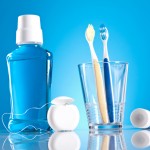
The regular use of interdental cleaning devices (e.g., floss and interdental brushes) are helpful to control biofilm formation interproximally and for the prevention of periodontal diseases. The additional use of active substances like chlorhexidine may provide additional benefit
The aim of this review was to assesses the efficacy of interdental cleaning devices used with active substances, as adjuncts to toothbrushing, in comparison with toothbrushing alone or with interproximal cleaning devices without an active substance or with a placebo substance.
Methods
Searches were conducted in the Medline/PubMed, Embase, Scopus, Cochrane Library (CENTRAL), and Web of Science databases. The were supplemented by hand searches of the journals, International Journal of Dental Hygiene, Journal of Dental Hygiene, Journal of Clinical Periodontology, and Journal of Periodontology. Two reviewers independently conducted the searches, selected studies, extracted data and assessed risk of bias using the Cochrane RoB 2 tool. Randomised controlled trials (RCTs) comparing interdental cleaning devices with any chemical substance as an adjunct to toothbrushing with interdental cleaning device without chemical substances or with a placebo substance were considered. The GRADE approach was used to assess the certainty of the evidence.
Results
- 7 RCTs involving a total of 104 patients were included.
- Follow up periods range from 2 days to 6 months.
- 5 studies used dental floss, 2 studies interdental brushes.
- 6 studies used Chlorhexidine (CHX) as an adjunct and one cetylpyridinium chloride (CPC).
- 3 studies were considered to be at high risk of bias and 4 at uncertain risk.
- Meta-analyses were not conducted.
- 4 studies noted significantly higher anti-gingivitis efficacy for interdental cleaning devices with active substances.
- 3 studies found significantly higher antiplaque efficacy for interdental cleaning devices with active substances.
- 6 RCTs evaluated side effects with none being reported.
- The GRADE certainty of the evidence was assessed as very low.
Conclusions
The authors concluded: –
Interdental cleaning devices used with active substances do not provide additional clinical benefits in terms of anti-gingivitis and antiplaque efficacies when compared with interdental cleaning devices alone. However, the use of dental floss with chlorhexidine may promote additional biofilm removal.
Comments
The 2019 Cochrane review of interdental cleaning devices (Dental Elf – 15th Apr 2019) concluded that,
Using floss or interdental brushes in addition to toothbrushing may reduce gingivitis or plaque, or both, more than toothbrushing alone. Interdental brushes may be more effective than floss.
The aim of this new review was to see whether the use of active substances would improve the efficacy of interdental cleaning. The authors have searched a good range of sources with 7 RCTS being identified. However, the included studies were small, the largest involving 26 patients with none of them being at low risk of bias. The studies were also heterogeneous using different devices, different concentrations of active substances, and different ways of using these active substances among studies. While the findings suggest some benefit from the use of interdental devices with active agents the quantity and quality of evidence is very low, so we are very uncertain of the effectiveness. Additional high quality well designed and reported studies of appropriate size are needed to properly assess the effectiveness of interdental cleaning devices with active substances.
Links
Primary Paper
Langa GPJ, Dantas PPA, Lemus GMR, Benítez Silva CG, Meza-Mauricio J, Muniz FWMG. Effectiveness of interdental cleaning devices with active substances: a systematic review. Clin Oral Investig. 2022 Jan 9. doi: 10.1007/s00784-021-04327-3. Epub ahead of print. PMID: 34999990.
Other references
Dental Elf – 14th Jun 2021
Rubber bristles interdental cleaners as an adjunct to toothbrushing
Dental Elf – 15th Apr 2019
Interdental cleaning devices for prevention and control of caries and periodontal disease
